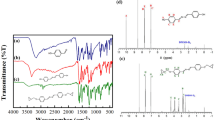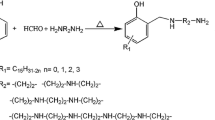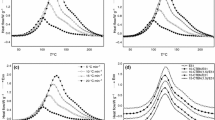Abstract
The novel interpenetrating polymer networks (IPNs) based on cycloaliphatic epoxy resin (CER) containing cyclohexene oxide groups and tri-functional acrylate, trimethylol-1, 1, 1-propane trimethacrylate (TMPTMA) were synthesized. The formation of the IPNs was on-line monitored by means of polarizing optical microscope, time-resolved light scattering and Fourier transform infrared spectroscopy. The morphological and mechanical properties of the resultant IPNs were investigated and evaluated with scanning electron microscopy (SEM) and dynamical thermal mechanical analysis (DTMA), respectively. The on-line monitoring results showed that during the course of the IPNs formation, the TMPTMA component was cured more quickly than the CER component, leading to the formation of the sequential IPNs. During the early curing stage, there were the phase separation phenomena in the CER/TMPTMA system. The SEM results revealed that although there were some slight phase separation phenomena in the CER/TMPTMA system in the early curing stage, the resultant IPNs displayed the homogeneous structures and did not show the apparent phase separation morphology. The DTMA results revealed that the resulting IPNs exhibited rather higher modulus and denser cross-linking network structure than the neat CER system.






Similar content being viewed by others
References
May CA (1988) Epoxy resins: chemistry and technology, 2nd edn. Dekker, New York
Goulding TM (1994) In: Pizzi A, Mattal KL (eds) Handbook of adhesive technology. Dekker, New York
Chen M, Ren AS, Wang JF, Lee MS, Dalton LR, Zhang H, Sun G, Steirer WH (1999) Polym Prepr 40:162
Cortes P, Montserrat S, Hutchinson JM (1997) J Appl Polym Sci 63:17
Suvarna S, Ambekar SY, Saletori M, Biswas C, Rajanna AV (2000) J Appl Polym Sci 77:2097
Sperling LH, Mishra V (1995) Polym Adv Technol 7:197
Suthar B, Xiao HX, Klempner D, Frisch KC (1996) Polym Adv Technol 7:221
Djomo H, Morin A, Damyanidu M, Meyer G (1983) Polymer 24:65
Nowers JR, Costanzo JA, Narasimhan B (2007) J Appl Polym Sci 104:891
Kim SJ, Yoon SG, Kim SI (2005) Polym Int 54:149
Dean K, Cook WD, Zipper MD, Burchill P (2001) Polymer 42:1345
Hsieh KH, Han JL, Yu CT, Fu SC (2001) Polymer 42:2491
Dean KM, Cook WD, Lin MY (2006) Eur Polym J 42:2872
Plesse C, Vidal F, Gauthier C, Pelletier JM, Chevrot C, Teyssie D (2007) Polymer 48:696
Flory PJJ (1941) Chem Phys 9:660
Huggins MLJ (1941) Chem Phys 9:440
Goossens S, Goderis B, Groeninckx G (2006) Macromolecules 39:2953
Zhan G, Yu Y, Tang X, Tao Q, Li S (2006) J Polym Sci Part B Polym Phys 44:517
Tao Q, Gan W, Yu Y, Wang M, Tang X, Li S (2004) Polymer 45:3505
Park S-J, Kwak G-H, Sumita M, Lee J-R (2000) Polym Eng Sci 40:2569
Qin C-L, Cai W-M, Cai J, Tang D-Y, Zhang J-S, Qin M (2004) Mater Chem Phys 85:402
Cowie JMG, Harris S, Gomez Ribelles JL, Meseguer JM, Romero F, Torregrosa C (1999) Macromolecules 105:3777
Tobolsky AV (1960) Properties and structure of polymer. Wiley, New York
Schonhals A, Kremer F (2002) Dielectric spectroscopy. Springer-Verlag, Berlin
Acknowledgements
Thanks are due to Prof. Shanjun Li, the Key Laboratory of Molecular Engineer of Polymer, Ministry of Education, Department of Macromolecular Science, Fudan University, for the discussion, kind advice and his help to supply measurement about TRLS. The authors gratefully acknowledge the financial support of Shanghai committee of Science Technology by the funds for Major Research Project of Shanghai City (No. 05dz22303).
Author information
Authors and Affiliations
Corresponding author
Rights and permissions
About this article
Cite this article
Duan, J., Kim, C. & Jiang, P. On-line monitoring of cycloaliphatic epoxy/acrylate interpenetrating polymer networks formation and characterization of their mechanical properties. J Polym Res 16, 45–54 (2009). https://doi.org/10.1007/s10965-008-9201-7
Received:
Accepted:
Published:
Issue Date:
DOI: https://doi.org/10.1007/s10965-008-9201-7




